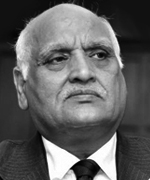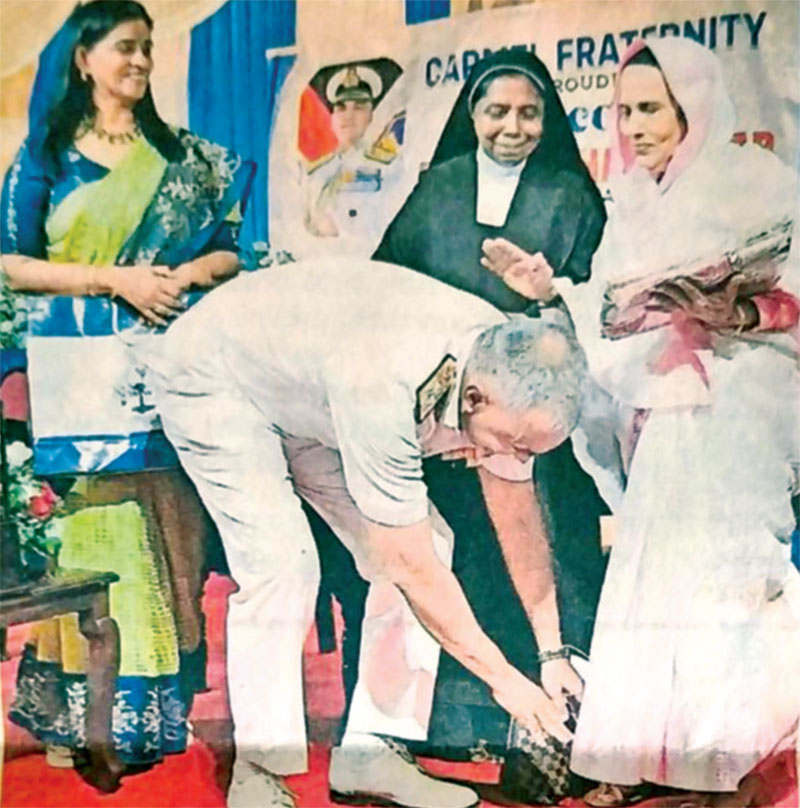A Matter of Military Honour March 2024
 Maj. Gen. Raj Mehta (retd)
Maj. Gen. Raj Mehta (retd)
On 14 January 2024, Western Army Commander Lt Gen. Manoj Kumar Katiyar who took over on 1 July 2023, spoke briefly at the Command Investiture ceremony about the ethos of the Army. “What makes the Indian Army stand out is that we strictly adhere to two important principles: our secular approach and our apolitical character,” he said. “It means we respect all religions and steer clear of politics. It is necessary to stick to apolitical and secular principles and recognise the fact that any compromise or lack of adherence on these fronts will be harmful for the Army.”
On 28 February 2024, Naval Chief Admiral R Hari Kumar won a billion plus hearts across India when he visited his alma mater Carmel Convent Higher Secondary School in Vazhuthacaud, Trivandrum. Watched by his proud wife and emotional school Director Sister Revita, the Admiral, in full dress uniform, touched his former teacher, a Muslim, Ms Jameela Beevi’s feet, recalling how she’d helped him clear the Malayalam language test to qualify for admission.
These examples of right secular conduct by apex military officers in the best traditions of the armed forces have warmed the cockles of serving/retired personnel’s hearts. This has made the recent controversy involving the leaking of sensitive excerpts from ex-army chief Gen. M.M. Naravane’s forthcoming book Four Stars of Destiny seem a small blip that caused momentary rancour.
Though Indian military history goes back to the Bronze Age (3300 to 1300 BCE), this article focuses on the contemporary Indian Army as it evolved starting from British rule in the mid-eighteenth century. The innocuous trade beginnings quickly converting to the raising of the Presidency Armies will be briefly discussed as also their merger into the British Indian Army, and it’s partitioning following the grant of Independence to India and Pakistan in August 1947. The focus will be on the legacy of the current Indian Army and how it is poised to execute its charter as a world benchmarked military force.
However, before proceeding further, an important ancient military referral is worth flagging. Romila Thapar in her History of Early India writes that the Nanda dynasty never had a chance to use their humungous Indo-Gangetic army of infantry, horse cavalry and war elephants against the Greeks as Alexander invaded India in 327 BC. Following his conquest of Persia, Alexander in two years crossed Punjab’s five rivers after his success on the Hydaspes (Jhelum), stopping on the Hyphasis (Beas) where his army mutinied fearing a losing clash with the Nandas. The battles, including the climacteric one against Porus, were hard-fought. Alexander was seriously wounded while retreating, leaving governors behind to manage his conquests. Young Emperor Chandragupta Maurya in 321 BC defeated the Nandas, bringing in for the first time, imperial ambitions and systems and a warfighting treatise, Arthashastra.

Adm. R. Hari Kumar with Mrs Kala Nair touching the feet of his old class teacher Jameela Beevi as school director Sr Renita looks on
British Traders and Conquerors
Christopher Gibbert in The Great Mutiny writes that the royal charter granted in 1600 in England to the East India Company (EIC) and Merchants of London for trade with the East Indies was encashed by the British Ambassador in Mughal Emperor Jahangir’s court in 1613 to establish a permanent trading station in Surat. The EIC directors were advised by their ambassadors at the Mughal court not to seek “plantation by the sword” like their predecessors, the Portuguese and the Dutch. In 1707 however, Aurangzeb died and thinly camouflaged opportunists the EIC harvested the chaos that followed to become a military and mercantile power. With France and England at war in Europe, war broke out between them in India too.
A scratch army raised by the company and commanded by Robert Clive, a former clerk in its Madras office, defeated the French and their Indian protégé at Plassey in 1757, making the British masters of Bengal. In 1773, Parliament appointed Warren Hastings as Governor General in Bengal with supervisory authority over the Bombay and Madras Presidencies. In 1784, a Crown Minister was appointed president of the board of control to oversee EIC officials. EIC over time became the agent of the British government in India. It also became responsible for the three Presidency Armies manned by sepoys and sowars. Native officers came in but the senior most was subordinate to the junior most British officer and couldn’t o
Subscribe To Force
Fuel Fearless Journalism with Your Yearly Subscription
SUBSCRIBE NOW
We don’t tell you how to do your job…
But we put the environment in which you do your job in perspective, so that when you step out you do so with the complete picture.







